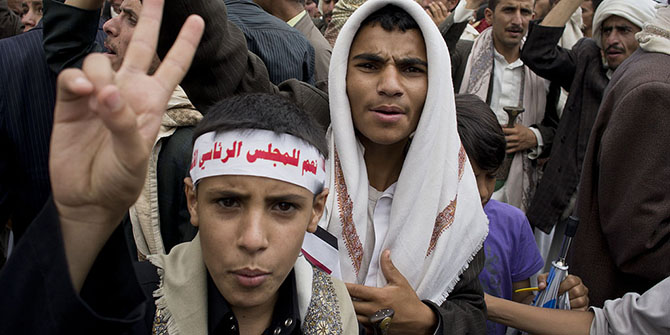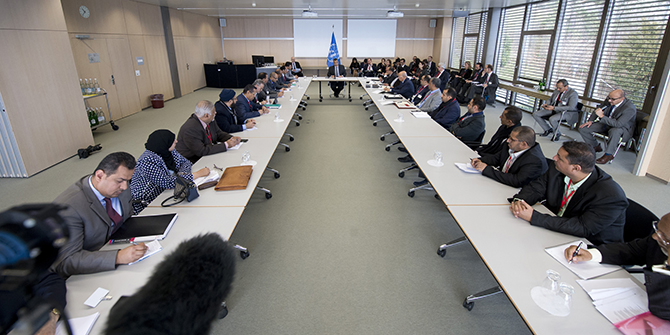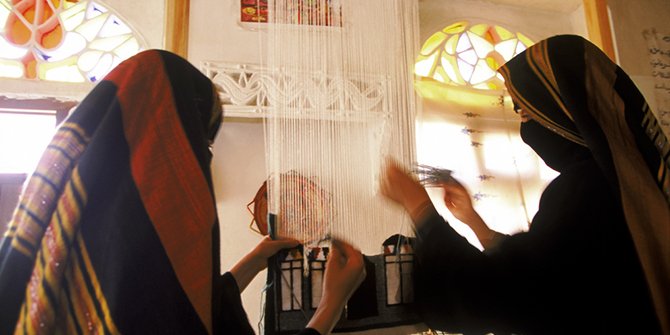by Rafat Al-Akhali
#LSEYemen
This memo was presented at a workshop on ‘Yemen’s Urban–Rural Divide and the Ultra-Localisation of the Civil War‘ organised by the LSE Middle East Centre on 29 March 2017.

March marked the second anniversary of the beginning of the war in Yemen. On one side stands the alliance of Houthi fighters (a small Zaydi Shiʿa clan based in the governorate of Saada) and forces loyal to ex-president Ali Abdullah Saleh. On the other are resistance groups and army units aligned with, or loyal, to the internationally-recognised government of President Abdurabbo Mansour Hadi and backed by a military coalition of Arab and Muslim countries led by Saudi Arabia.
While most headlines track military battles for territory control the political battles to establish legitimacy, a much more hidden, yet no less destructive battle has been underway in Yemen – that of control over key economic resources and institutions.
The most visible conflict on the economic front has been the fight over control of the Central Bank of Yemen (CBY), which brewed for over 2 years since March 2015 until the internationally-recognised Hadi government officially replaced its board and relocated its headquarters from the Houthi–Saleh-controlled Sana‘a to Aden, which it designated as the temporary capital in March 2015.
As the banking sector slowly collapses due to the ongoing conflict, and with the erosion of the CBY’s supervisory and regulatory functions, the black market for currency exchange and international money transfers is flourishing. There are significant profits in this market, in addition to opportunities for money laundering and other illicit financial transactions. A network of currency exchangers with links to the warring parties operate this black market, sharing their gains with the different parties in return for protection and permission to operate.
Oil-producing regions, most notably Marib and Hadhramaut, present another contested economic resource. The Houthi–Saleh alliance has lost on this front, since it doesn’t have control over those regions. However, the natural resources of those regions are largely under the control of the local communities, rather than the internationally-recognised government, which is a clear sign of the fragmentation challenge awaiting Yemen even if the major war comes to an end.
Closely tied to oil production is the business of supplying fuel products (diesel, gasoline, cooking gas) for power generation and other uses. Again, this is an area with significant profits, especially as both the de jure and de facto governments are unable to import fuel themselves and rely almost exclusively on private suppliers to import it, and in many cases distribute it. Here again, only private suppliers connected to either of the warring parties are given licenses to import fuel.
Control over who imports fuel depends on control of the main ports. This leads to regular clashes and conflict between different local militia groups in Aden over the control of the port. It also explains why the Houthi–Saleh alliance is desperately fighting to defend the Port of Hodeidah, the last sea port it still controls. Ports are not only important for the import of fuel, but are also crucial for the last available revenue streams, customs revenue. In 2013, the year before the Houthis took control of Hodeidah, the port brought in 41 percent of all customs revenue, amounting to over $400 million.
Finally, the telecommunication sector is typically one of the few sectors that remains operating during conflict. In Yemen, there are three private mobile network operators and one state-owned operator, all headquartered in Sana‘a. So far, they have been paying their taxes to the Houthi–Saleh authorities. There have been multiple reports about the Hadi government attempting to license a new operator in Aden in order to avoid using the existing infrastructure of companies headquartered in Sana‘a, and to of course benefit from the licensing fees plus subsequent tax revenues. On the other side, the Houthi–Saleh alliance has been attempting to grant a license to a new operator in Sana‘a reportedly owned by one of their associates, again to benefit from the licensing fees, which is expected to exceed $100 million.
Contrary to how it is often portrayed in international media, the conflict in Yemen is not simply a regional proxy war. It is a ferocious fight between local warlords to gain control of key economic resources. Sadly, millions of innocent Yemenis are paying the price and falling victim to what has now become the largest humanitarian crisis in the world.
Rafat Al-Akhali is Fellow of Practice, Strategic Projects at the Blavatnik School of Government, University of Oxford. He was appointed in November 2014 as Minister of Youth and Sports in the Government of Yemen, a post he held until September 2015. He tweets at @ymnraf.
Other Contributions in the Series
- Yemen’s Rural Population: Ignored in an Already-Forgotten War, Helen Lackner
- Empire of Information: The War on Yemen and its Agricultural Sector, Martha Mundy
- Saada: Ground Zero, Gabriele vom Bruck
- From Protesters to Politicians: The Rise of the Houthis, Nawal Al-Maghafi
- Taiz Youth: Between Conflict and Political Participation, Maged Sultan
- Community Responses to Conflict in Taiz, Kate Nevens
- Healthcare under Siege in Taiz, Sophie Désoulières
- Aden: Relief Challenges and Opportunities, Awssan Kamal
- Marib: Local Changes and the Impact on the Future of Yemeni Politics, Alkhatab Al-Rawhani
- Hadhramout from Federalism to Civil War: Demands and Realities, Baraa Shiban







It is, on the short to medium term. There’s definitely more to this war than the current battle to control the economy.